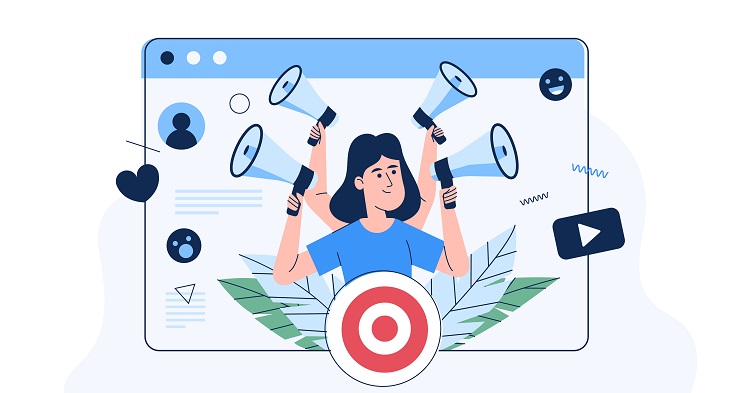It utilizes different forms of media, such as newsletters, videos, podcasts, blogs, and more. By consistently putting out valuable content, your business will show it has thought leadership in line with your brand’s message.
14 Steps to Develop a Successful Content Marketing Strategy 2023
Creating a content marketing strategy that has success takes a little bit of time. However, time is well spent because it will establish your business as a top source of information. So, how do you begin to develop your content marketing strategy? Read on to see the 13 steps necessary to develop a successful content marketing strategy.
Set Your Mission and Your Goals
The first step to having a successful content marketing strategy is to identify your mission and goals. Your marketing efforts begin with these two things. Why are they so important? These two elements form the foundation upon which your entire strategy will hinge. First, set your mission. Your mission should be an overview of what you wish to accomplish with your marketing strategy. This means you need to have good brand awareness. This will take the form of a mission statement. This is not a statement that will be made public. Instead, it is used internally to help guide the process. Breaking down the mission statement into its core elements shows its importance:
Your mission statement should include your target audience. Ask yourself, “Who am I trying to reach with this content?” Your mission statement should also include the specific types of content (media) you wish to use. Do you want to focus on blogs or videos? Both? Your mission statement should include what your audience will gain from your content, namely, what benefit will they receive by consuming your content.
Once you have made your mission statement, it is time to make a list of all your goals. As one study conducted by Gail Matthews shows, people who write down their goals are 20% more likely to succeed than their counterparts who do not. The goals you create are what you want to gain from your content marketing. Common goals include:
Making more sales Having success with SEO (Search Engine Optimization) Driving more traffic to your website Initiating more engagement on social media platforms
These are all actionable goals. Each of these goals, along with many others you may have, can be achieved through content marketing. Ask yourself exactly what you hope to gain through your content marketing. Start with one business goal and go from there. These goals will form a sort of “road map” to your success.
Know Your Audience
Once you have your mission and your goals written down, it is time to move to the next step. You should know what exactly it is you wish to accomplish for your business. However, how do you get there? You must know your audience. In your mission statement, you will have identified your audience. However, you will need to research your audience a bit more to truly understand what it is they want. Creating an “audience persona” is a strategy that can really help in the long run. An audience persona is a semi-fictional representation you create of what your ideal audience member would look like. In other words, a person who would use your services, what exactly would their lives look like? As one survey pointed out, 90% of b2b marketers that used buyer personas, like audience personas, had a much clearer understanding of their audience. Knowing your audience is crucial because you want to cater your content to them. Remember, content marketing is about content geared toward your audience. If you know the type of content your audience will want to consume, it will make your job much easier. You will be able to cater your efforts to what you know they will want, not just what you think they will want. For example, if your audience is younger and active on social media then it may be best to cater your efforts toward your social media presence. Create content that can be easily shared on different social media platforms. As a content marketer, you must think as your customers think. One important note to remember: not everyone who will consume your content is a buyer. Your content should still be engaging for all who stumble across it.
Content Marketing Strategy
Before moving on to the next step, let’s consider your sales funnel as its key to your future success. Also known as a marketing funnel, you can use this strategy to sell virtually anything. However, you do need to master 3 crucial skills:
Creating irresistible offers around your products Telling your prospects a story Getting your audience’s attention
Assess Your Current Position
Your next step on your way to creating a successful content marketing strategy is to assess your current position. Whether you use social media, blogging platforms, YouTube, or any other method, you need to conduct an audit of the digital content you already have. Now, if you are starting out and do not have any content, you will not need to do a content audit. Your main goal should be to begin building your library of content. However, even if you just have a little bit of existing content, it is important to organize all of it. You can use online tools such as Screaming Frog to help sort your content, or you can do it manually. An audit of your digital content will allow you to see the types of content you have in place. Here are the elements you will need to log:
URLs of content. This will allow you to see if there is any duplicate content Titles of content Descriptions of content Content lengths Backlinks
By sorting these elements, you will see how useful your content is. Moreover, you will notice any gaps in your content. Are there things you could be focusing on that you are not? A full audit of your content will show you.
Figure Out the Best Content Channels
Content creation is only part of using content as part of your marketing strategy. You need to know the best content channels to distribute what you have created. Lead generation is important, so choosing the proper channels to reach the widest, most relevant audience is crucial. Traditional marketing, in the past, focused on print forms of media. However, in today’s world, you have to focus your efforts online. Consider the following content channels:
Facebook Instagram Blogging platforms (such as WordPress) Twitter YouTube
Of course, these are just a small selection of channels you can choose from. If you know the type of content you wish to create, choosing can be a bit easier. However, it is important to remember, as one study showed, that by 2022 around 82% of all online traffic will be for video. Therefore, it is important to focus at least some of your efforts on video. For example, if you want to focus on video, it is important to use content platforms that support videos. YouTube is an obvious choice, but most platforms have some video-sharing options available. Moreover, which platforms have editorial calendars to help you with posting? Additionally, it is important to check the analytics of your site. Which platforms get the most visits and shares? Use this information to gear your company in the right direction.
Choose a Content Management System
Choosing a content management system is also an important step in the process of making a successful content management strategy. Your content strategy needs to include a CMS because it will form the center of your business. A content management system, or CMS, is the system on which you can host your website. An example of a CMS is WordPress or Wix. As one survey noted, nearly 33% of marketing budgets go toward content management systems. Therefore, you need to pick the right one. Your website is a crucial element of your digital marketing strategy. Whether you are trying to reach a potential customer or an existing one, having a well-constructed website is key. Choose a CMS that will complement the content you wish to produce. Moreover, choose a CMS that you can handle, especially if you are a team of one or two. The more complex the CMS is, the more likely you will need others to help you. Consider your budget during this stage. Remember, your website is a vital part of your inbound marketing, so taking the time to choose a good content management system is worth the time investment. One final point about the benefits of a good content management system is that it will allow your content team to build consistent brand assets on demand automatically. For the team content creation will feel almost effortless. They’ll be able to use custom templates, on-brand and on-demand without taking up extra time.
Research Your Audience’s Needs
By this point, you will know what your audience is in a general sense. However, it is important to break your audience down even further. Once you know more about your audience, you can understand their needs more fully. Once you understand their needs, you can create great content that is both meaningful and relevant for them. So, how do you research your audience’s needs? The first thing to do is to break your audience down into different categories. These categories can include:
Your audience’s age (this could be different age ranges, such as 20-30, 30-40, and so on). Your audience’s gender (you could split this up into percentages to see what gender your company leans more toward). Your audience’s location. If you see that most of your audience hails from a specific area, you can gear your marketing efforts to that geographical location.
You could break your audience down even further, such as by income, marital status, or educational background. You can decide what makes the most sense for your purposes. Once you have a better idea of your audience, you can begin to collect data from your sales team to see what their needs are. You may also run a survey via a social media post to see what your customers are looking for. The more information you have on your audience the more informed you will be when it comes time to make content for them.
Decide on Content Types
Now that you have the bulk of the foundational steps completed, it is time to decide on content types. Deciding what kind of content, you wish to produce is easy once you know your audience. As mentioned earlier, video is a major part of marketing in today’s world. You will probably have a video on your list, but there are other types of content to choose from, too. It is important to remember the different types of content you may be considering, such as:
Blog posts Social media posts Videos Newsletters Podcasts E-books
Whatever you decide upon, you must keep your audience in mind. Ask yourself, how will your audience benefit most from your content? If they are a younger audience, social media may be the best platform. Social media is highly versatile and can incorporate different media types. A documented content marketing strategy will include a list of the content you wish to produce. It is important to create content that will allow you to reach your goals. Choose what will benefit your business, too. Take, for example, the statistic that a website that has blog content will have 434% more indexed pages.
Identify and Allocate Resources
The next step in your strategy is to identify and allocate resources. To reach your target audience, you will need good content that is consistently released. It is easy to drift off-track. How do identifying and allocating resources help you stay on track? When you identify and allocate resources, you are doing more than just researching the content. You are creating a content plan from beginning to end. You will identify:
Who is creating (and maintaining) the content you will produce? What tools will you need to create the content in question? How will you schedule content, including workflow?
First, decide who will create the content. If you own a small business, this will most likely be you. However, you may have a content team. If so, identify the types of content they are responsible for. Second, decide what tools you will need to create the content. For example, if you are focusing on video content, you will need filming equipment, such as an HD camera, lighting, audio recorders, and editing software. Third, identify how you will schedule the content. This includes creating a workflow—who will research the content, who will create the content, and so on. Scheduling your content will maintain consistency. You can use an editorial calendar for this, or you may find another calendar app that can get the job done. The workflow is also important. For example, consider a typical blog post’s workflow. A blog post must be approved, written, submitted for editing, have accompanying photographs approved and supplied, be uploaded, and, finally, be published.
Create a Content Calendar
As mentioned in step 8, having a content calendar is important if you want to consistently reach your target audience. Consistency is key to remaining relevant online. For your content strategy to hit all the points in your marketing plan, a calendar is crucial. A content calendar will help you maintain both consistency and workflow. A content calendar, or editorial calendar, will help you keep track of all your content. This is especially helpful once you have a large library of content or when your business is large. Consider what an editorial calendar will do:
It will keep all your content organized. It will allow you to see when things must be posted. It will show you your progress on each piece of content. It will show you the content you have completed. It will keep all team members focused.
Once you create a content calendar, you will be able to keep track of all content creation without issues.
Brainstorm Content Ideas
Before you create the content, you need to brainstorm with your team some content ideas. You may have a general idea of what you want to create, but brainstorming will help you effectively meet your marketing goals. When you brainstorm content ideas, you will be coming up with a large selection of content. This means that you will have ideas for many pieces that can fit into your content strategy. Your content strategy includes all the different ideas you want to promote. As David Henningsen, who conducted a study, said: “Groups that focus on both the number of ideas and building on the ideas of others significantly increase their cohesiveness.” You want to create quality content, and brainstorming is a way to do that. Brainstorming is a strategy where different team members can bring forward different ideas. You then all work on those ideas in a collaborative way, sometimes discovering new ideas in the process. Your content marketing strategy includes consistency. Consistency means having enough content to reliably publish on a regular basis. Therefore, having brainstorming sessions is important because it can yield a bulk of ideas for content creation that can be turned into deliverables.
Create the Content
Whether your content is going on social media or your company’s website, there is a lot of prep work. However, when you start creating your content marketing strategy, you are looking toward content creation. Make sure you refer to your calendar to know when you need the content completed. Quality content takes time, but you must remain on schedule. Once you know when it is due, you can begin to research information for the content. Using a blog post as an example, you would first brainstorm the idea behind the article. Once an idea has been agreed upon, it is time to research the content. Using reliable sources, you can start to build up a great foundation to work from. When creating your content, it is important to keep a marketing funnel in mind. The marketing funnel consists of:
Awareness Consideration Conversion
These three steps should be worked into all your content. Your content marketing efforts will yield good results when you do so. Any marketing strategy that aims to be successful needs to look at the audience in these stages. Consider the pain points of your audience, and use these points to help construct the content. For example, “awareness” is when your customer becomes aware of what you offer. “Consideration” is when they consider using your services, and “conversion” is when they actually use your services. Therefore, your content strategy must keep this in mind. To create quality content that will lead to conversions, you have to know what your audience wants. It is easy to see why all the prep work was important when it comes to creating the content. Your content marketing plan includes all the steps necessary to effectively complete the content.
Distribute and Market
Once you have created your content, and you have edited and approved it, it is time to publish it. Your content strategy will help you decide how exactly you want to do this. If your content marketing goal is to reach more people via email, then it is vital you find a reliable email distribution tool. MailChimp, for example, is a tool that can help you create mass-marketed emails and newsletters. However, there must be a marketing strategy for how you will advertise your content. It is not enough to just post it on your website and hope it gains traction. A documented strategy for content promotion is online marketing. By using your social media platforms, you can both organically and monetarily advertise your content. Make sure to hit all possible ways for people to find your content. A marketing strategy geared towards the places where your audience visits most is crucial. Consider the ways you may distribute your content:
Social Media (Facebook, Instagram, Twitter) Your website (Blogs, photographs, newsletters) Emails (email marketing and newsletters) Podcast hosting websites
The type of content you create will dictate the precise method you use to distribute it.
Track and Evaluate Content Performance
Your content marketing strategy may change over time. To make changes to your marketing strategy you need to know how your current content is performing. You have put a lot of work into the content you are publishing, but you want to make sure it is paying off. Part of your content strategy is to track and evaluate the performance of all your content. How do you do this?
Use Google Analytics. Google Analytics is a great tool that will show you how well your content is doing and how it is reaching your audience. Use Buzzsumo to monitor your social media sites to see how content there is doing. Use built-in plugins. Social media sites, CMSs, and other platforms, usually have an analytics tool of some kind. If not, they may have a plugin you can use.
Regardless of how you monitor your content’s performance, you must do it. If, for example, a blog post is not doing well, you can tweak your content strategy accordingly. This is true for every piece of content. You will be able to make informed decisions about not only your content but also your content strategy.
Conclusion
Your content strategy is important because it leads to success. By following these steps, you will establish your company as a reliable and trustworthy voice. A content marketing strategy will also push you in the right direction. About







